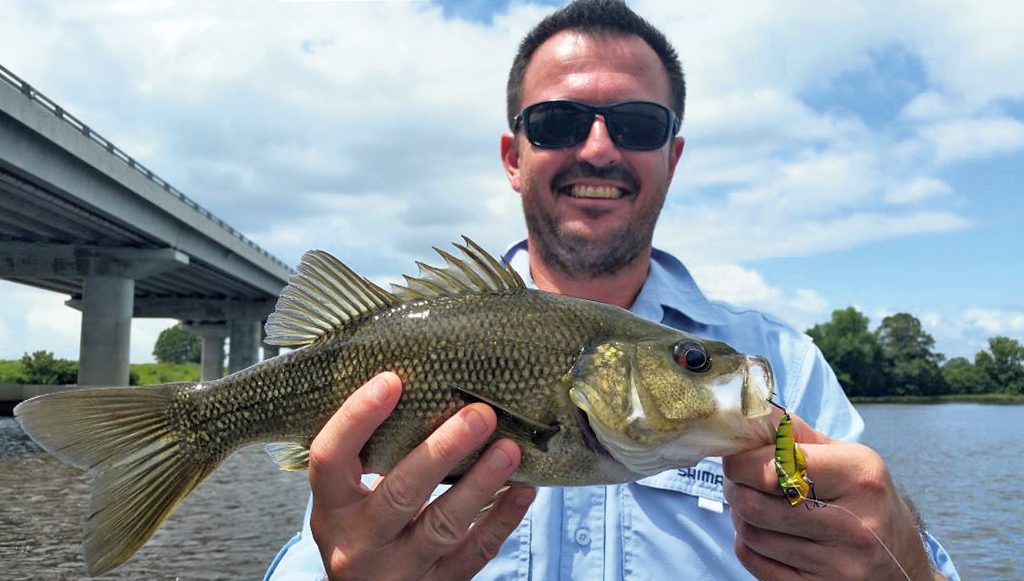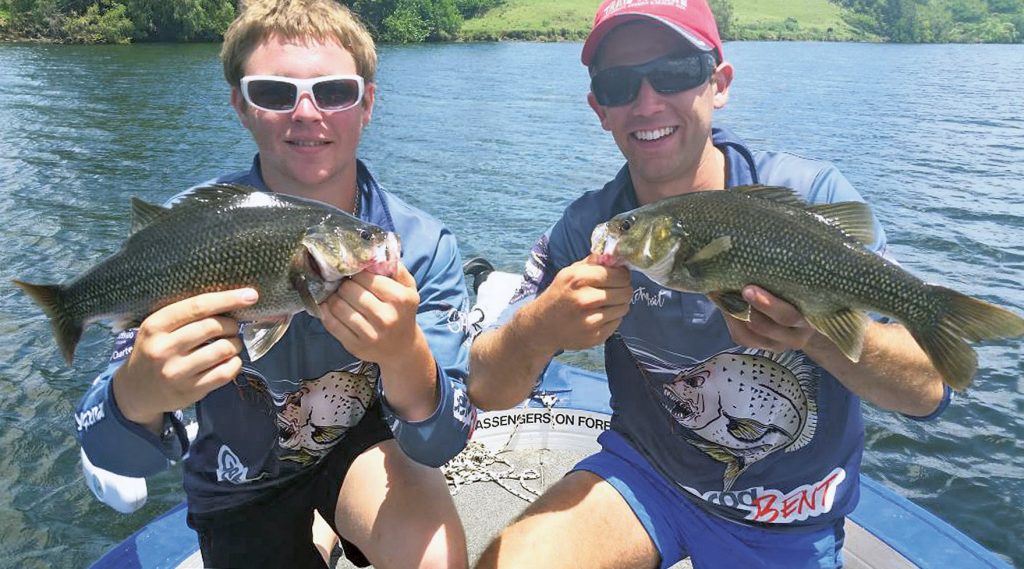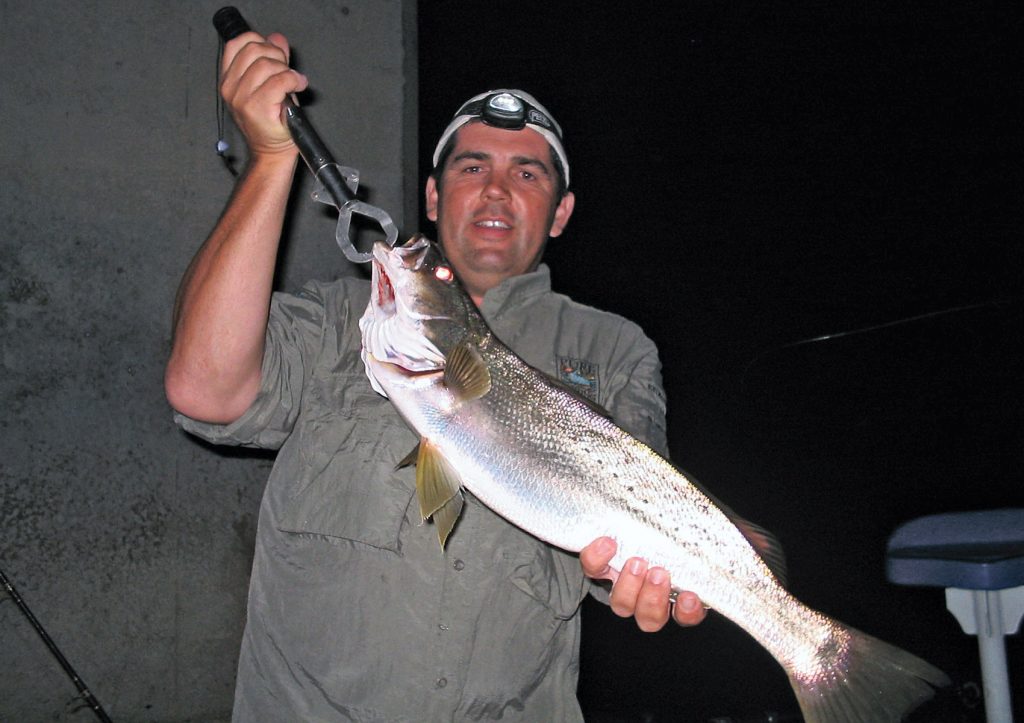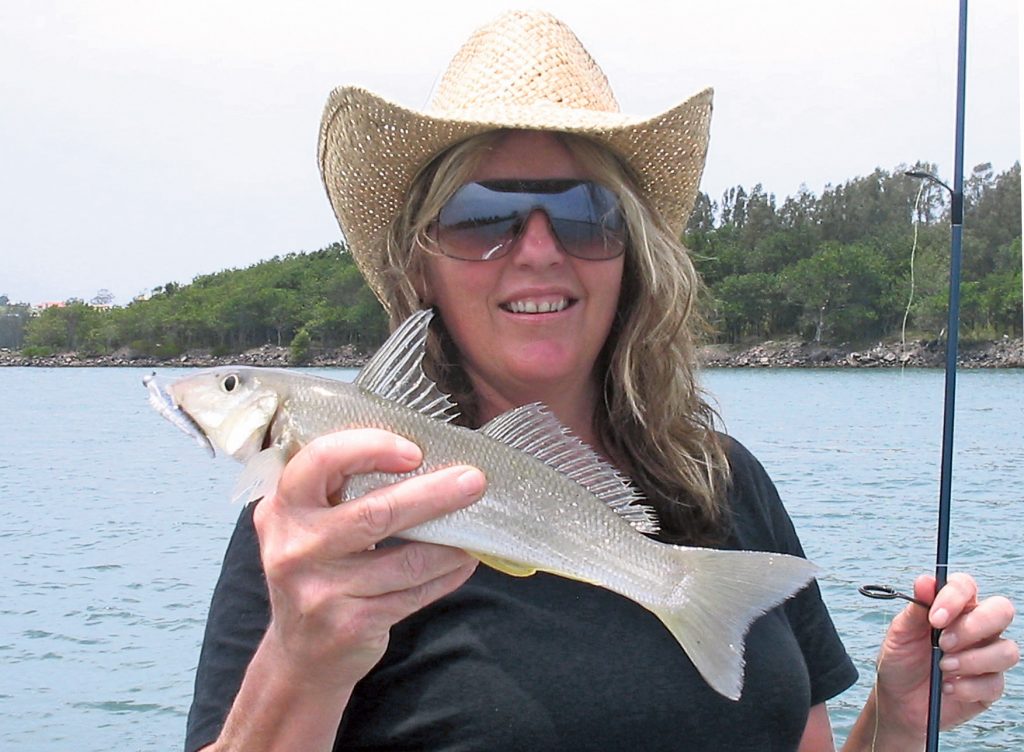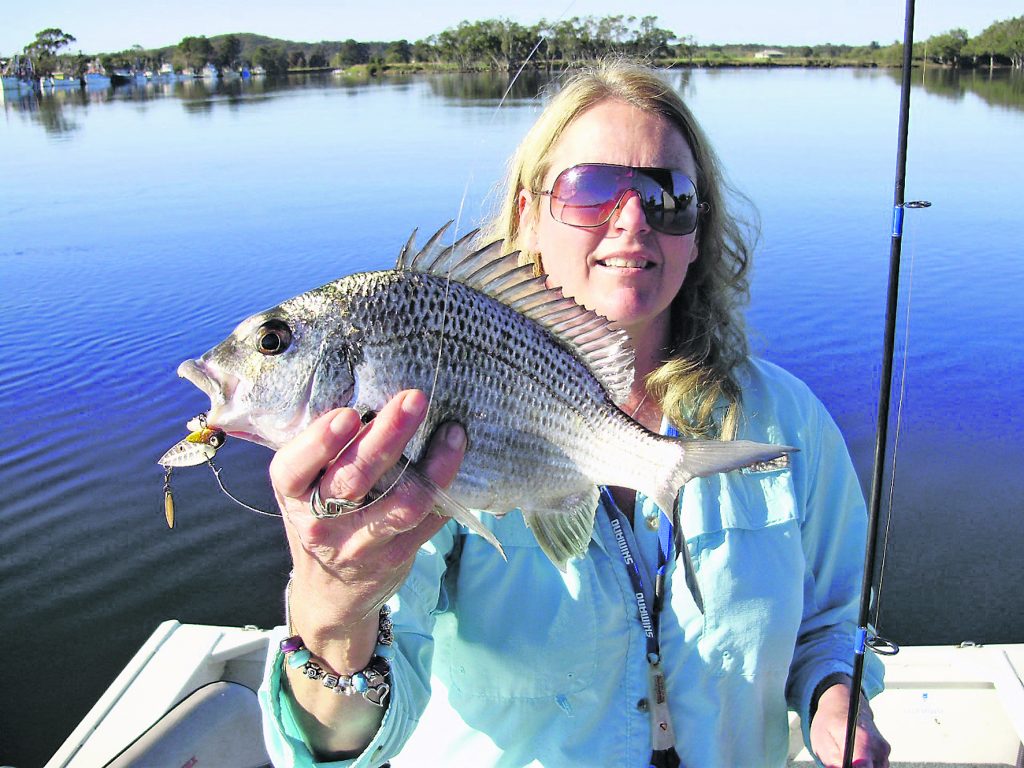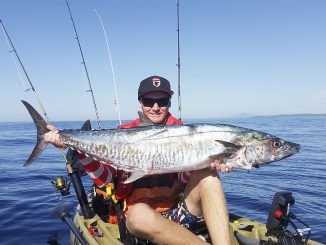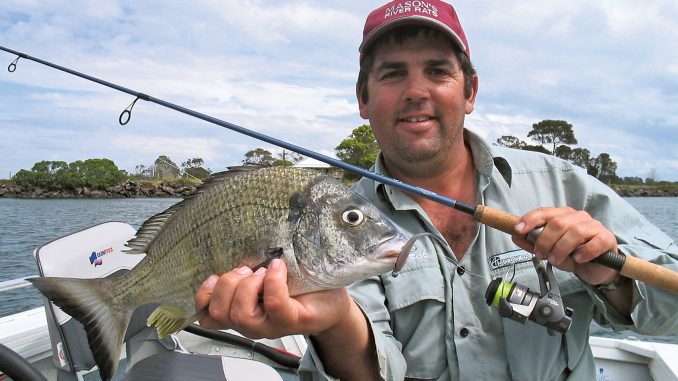
By Mark Saxon •
The majestic and sometimes wild Macleay River is formed by the confluence of the Gara River, Bakers Creek and Salisbury Waters, with the river rising below Blue Knobby Mountain, which is east of Uralla on the Great Dividing Range. In length, the river runs 298km and flows through the city of Kempsey on its way to the mouth of the South Pacific Ocean at the picturesque small town of South West Rocks. For the specifics of this article, we will talk about fishing options from Belgrave Falls, which is the start of the tidal section, down to the mouth.
THE ENTRANCE UP TO JERSEYVILLE BRIDGE
My first association with this waterway was in 2000, and my early impressions can only be described as being in awe of the fishing potential. On any given day you can catch your saltwater favourites, plus that Australian freshwater icon, the bass, within just a few kilometres — and sometimes in the very same area! Let’s start at the mouth and meander our way up-river and look at the bridges.
The walls are famous for luderick, bream, tailor and mulloway (jewfish), with some really big specimens of the latter coming from these walls after flooding occurs. For the boating angler, the North Wall all the way up to The Cut can be excellent for throwing soft plastics and vibration blades around for bream, using your electric to work the area. Cast close to where the rocks meet the river floor, as this is the ideal area for them. Be warned though, the odd mangrove jack does inhabit this wall and not very often does our standard light bream outfits make the grade with these explosive fish.
Also, when chasing mulloway we do the same — upgrade the gear to slightly heavier 4-6kg rods and use 15lb braid and 20lb leader attached to 4-7” plastics. Again, cast to the edges and work lures back with plenty of pauses. This will be best done as the tide slows, and either high or low can produce. Big flatties can also get into the act.
When the tide starts to flow again, we can go back to chasing bream. In winter, these walls do have a lot of anglers chasing blackfish, and great catches can be taken using traditional stem floats with green weed setups.
At The Cut, which is on the bend as you go around to Shark Island and Stuarts Point, there is always the chance of tangling with a mulloway or big flathead. The same can be said about Kemps Corner — some really big fish have come from here over the years, mainly of a night and using live bait such as tailor, herring, mullet or pike. In saying that, fresh blackfish and mullet fillets account for quite a few fish from here.
The township of Stuarts Point and back to the main river is a place where you can spend plenty of time fishing the shallows. Try for whiting on poppers, or small hardbody shallow divers around the racks for bream. Both techniques are great ways to spend a few hours and also very rewarding. For the bait fishers, some pink nippers, worms or fresh green prawns will see you amongst the flatties and whiting on some of the shallow sandy stretches in this section.
Spencers Creek is another spot where the use of small diving lures or light plastics will get you onto some bream and flatties. Using surface poppers for bream has produced good fish here in the summer months, and if there is weed beds outside the creek mouth, a well worked surface lure will produce more of them plus the occasional surface marauding flathead. Spencers Creek is also a good spot to get some mud crabs.
Fishing the rock walls at Rainbow Beach on the way up to Jerseyville Bridge is an area where anything can turn up, from bream, dusky flathead, trevally, mulloway, and even the odd cobia. Consequently, you will need to adjust the gear to suit the species. The wall here is also a good place to fish a live bait after dark, as it is close to the water and you won’t need to clamber down the rocks if you hook a good fish.
On the South West Rocks side bank leading to Jerseyville Bridge lies a stretch of deeper water, and along the wall you can have great bream action throwing small plastics in towards the rocks. This is a spot where school size mulloway can be present in numbers at times, and hopping a bigger plastic or drifting a live bait can produce excellent results. As always, remember to check size limits. Mulloway are now 70cm and anything smaller please handle carefully and send back to keep these amazing fish thriving. This spot can also hold big numbers of bigeye trevally at times and these are good fun on light gear.
This brings us to one of my favourite forms of structure and that is our first bridge on our trip upstream — Jerseyville. Now this bridge is good for a few reasons. One is the plentiful supply of herring, and the second is the boat ramp and park right next to the bridge. I like to night fish here, as it takes very little effort to get to and from the ramp, and it produces mulloway, bream and sharks. When I fish here I take a rod set up with a bait jig, and either the pylons or near the trawlers produces a good supply of bait. In saying that, with the lighting on the bridge, a lot of time you can jig up bait while tied off and fishing.
At this location I prefer the slack high tide and the start of the run-out, fishing either the dark or full moon periods. This is a great way to spend an evening. Take a thermos of warm drink and a good feed, and sit back and wait for a reel to scream. When you are finished, it is then just 100m back to the ramp!
For shore-based anglers, the park itself can be easily fished. Plenty of quality bream and mulloway come from here. In daylight hours, throwing plastics and some of the latest soft vibes account for a lot of mulloway as well. Once again, fishing the slack water, be it low or high, you will be in with a chance of 1 of this system’s best rewards.
JERSEYVILLE BRIDGE TO FREDERICKTON BRIDGE
As we travel further upstream towards the mouth of Kinchella Creek, you will encounter sand banks. These are places, especially in warmer months, that drifting or under the power of an electric motor will produce flathead and whiting. This spot can also be good to troll some smaller diving lures; don’t neglect this option, as sometimes it can save a quiet day. I like to have my lures a reasonable distance, approximately 30m, behind the boat, and troll them at a medium walking pace. You will know if lure is working by the steady vibration of the rod tip. If it stops vibrating, wind in and check for weed. As we hit the mouth of Kinchella Creek, we can target bream, and some good fish get pulled from here each year. Flatties come from this location as well.
The next area we come too sees us starting on the crossover with Smithtown. This is a spot where you can land bream, flathead, mulloway and bass in a single session (remember that the bass closed season runs from June 1 to August 31). Plenty of times around the pylons at Smithtown you will have a session where you get plenty of bass and a few bream, and then the next day have a complete reversal, landing more bream than bass. A few things that account for this are firstly spawning movement, but rainfall and salinity levels are other considerations. One thing though, it does make for enjoyable lure fishing. I would say my favourite all-round lure at this bridge is definitely a vibration blade. Just mix up the colours until you find a winner. Plastics do work, but I find the flathead can enjoy them too much at times.
From Smithtown Bridge you will pass the Belmore River, and at times this spot can be a bass holding area, moreso in the spawning season. It also has bream and flathead in residence. The deeper water behind the Nestle factory can produce some trophy bass. Try fishing blades and Jackall style lures. They can be good here, and lately with the production of so many great looking soft vibes, try throwing something that hasn’t been seen as much yet. It could get you hooked into some serious fish.
There is a boat ramp at Smithtown if you want to base your fishing in this part of the river.
Travelling further upstream, we have Australia’s longest road bridge, the Macleay River Bridge. With a length of 3.2km, it was completed in March 2013. The best thing I can say about it is the fish love it! It is a favourite springtime location, and then again in autumn. The depth it isn’t overly great at 3.5-4m at the deepest, so several methods produce bass. Here again, blades are a standout. Plastics and deeper diving hardbody lures in the 3m range worked as well, with some mornings producing constant hookups. Already, several bass over 50cm have been caught from this location, so definitely give it a look.
FREDERICKTON TO KEMPSEY
Past the bridge upstream are plenty of weed beds, so fishing a small popper, walk-the-dog style lure, or cicada imitation surface plug can get you into the bream and bass that frequent such areas. As we move up towards the city of Kempsey, you will see several shallow weed beds on the eastern side. These are worth surface fishing early and then switching to spinnerbaits when sun rises, as you can have big days in these spots when bass are in the weed.
All you need to remember is that each weed bed can hold fish. Some hold them all season, while others are a bit hit and miss. This may depend on the predominant bait species available. Keep on moving from bed to bed and you will find them.
In Kempsey itself, you have another bridge and also a rail bridge, both of which produce fish. In the town area, a few anglers fish here of a night using surface lures straight across from the boat ramp. The thing you will notice from the area is the shoreline opposite the ramp is full of bamboo and lots of bats. Of a night, tie on a surface walker style of lure like a Jitterbug. Hearing that plip, plop across the water, followed by an almighty explosion is pretty exciting stuff for any bass fisho. If that doesn’t get the heart beating, call triple 0.
KEMPSEY TO BELGRAVE
This area from Kempsey through Greenhills and all the way to Sherwood produces some of the best bass fishing on the mid north coast. There is another boat ramp at Greenhills, but really suitable for small boats, as at low tide there is a bit of a drop there, so be cautious.
This area is worth spending a fair bit of time in, especially from October to February. Getting up early and being on the water before daybreak can mean the difference between exceptional surface fishing and just getting a few. All manner of surface lures will work — fizzers, crawlers, poppers, and dog walkers. This season there was an exceptional amount of small baitfish skipping over the surface, so Sammy style lures performed very well. The year before though, cicada numbers were at an all-time high, and therefore those imitations worked a treat. As they say, match the hatch.
An important feature about this part of the river is the weed, and believe me, there is plenty. Do not stress this; instead, use it to your advantage. Fish slightly heavier braid of 10-12lb and leaders of 12-16lb. This will seem light when you hook a bulldozing bass that wants to go straight back into the jungle. High tide is the preferred period over the weed beds.
Okay, we have been talking surface, but lastly on this section of weed fishing we must mention a lure that does produce big numbers at times and that is the spinnerbait. They’re a very simple but effective way to work the weed, slow rolling with the occasional twitch to remove any buildup. This technique is productive, but make sure you have a firm grip on your rod as some of the hits can really wake you up.
I should mention that in this part of the river we do still catch bream on the surface and the occasional flathead on spinnerbaits, which again adds to the magic of the area. This season the weed has been very thick, so casting plastics and hardbody lures has been near impossible, with the weed right up in a lot of the snags as well. There are a few spots still suitable, but not many.
The magical thing is that each season is different and what was a weedbed fishery this year could be gone with the next flood. Spots change, especially at this end of the tidal range, so always think about it and look at what is happening on the water and under it.


